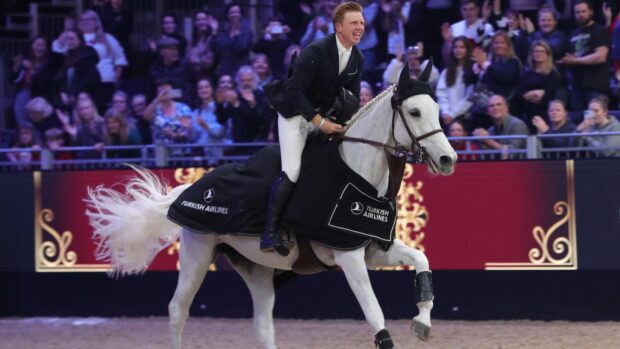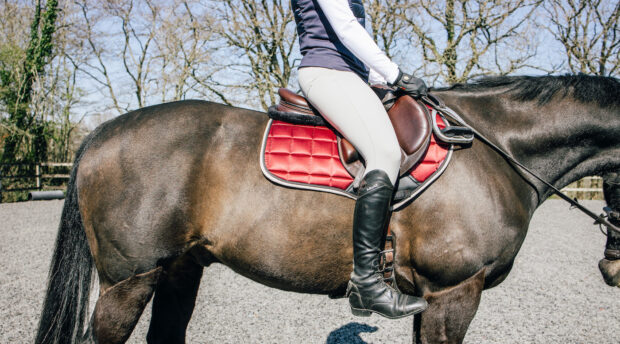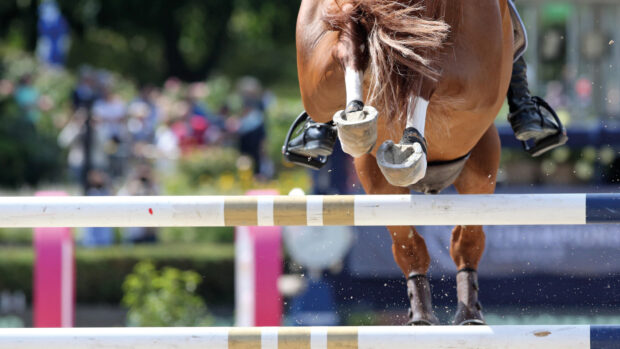In this exclusive, subscriber-only interview, Becky Moody shares what she looks for in a young horse and we delve into her training routine and the ethos that helped get her home-bred Jagerbomb to the Paris Olympics
One of the most remarkable aspects of Becky Moody and Jagerbomb’s success at the Paris Olympics was that Becky not only rode but also bred and trained Jagerbomb herself, guiding him through every stage of his development.
In a sport often clouded by the misconception that wealth and privilege are required to reach the top, their journey highlighted what’s possible through dedication and skill, making their achievements all the more inspiring.
Becky’s had to be patient throughout a career that’s had its fair share of ups and downs, and that patience carries over to her approach to training.
“The most important thing is that the horses go at the rate that they need to go at, and that you have their bodies and minds in the right place to do it,” Becky explains. “I don’t have any hard and fast rules when it comes to training them through the levels.
“Although I did say for many years that I’d never buy something that was backed without sitting on it, but I broke that rule over Covid when Rebecca Dudley, an agent I work with a lot, rang me about a very nice three-year-old that she thought was my kind of horse. That was Magic Dream – she was the first one we took a punt on and bought without riding.”

Becky Moody and her national seven-year-old champion Magic Dream training at home. Credit: Steve Dawe
That punt looks to have paid off handsomely with Magic Dream being crowned the national seven-year-old champion this September.
As we delve more into her approach to training, Becky shares what she values most when assessing young horses, highlighting the key traits she believes are essential for developing future grand prix competitors
“When they’re less than three years old I find it really hard because I’m not experienced enough looking at youngstock,” she said. “The thing I struggle with at that point is to see what they’re going to end up like conformationally, unless you catch them at the three-weeks or three-month stage.
“But I’ll take a risk on a pretty face,” she laughs. “What I’m looking for is looseness and how the horse pushes energy through their body, and the ease with which they move.
“One of the biggest things I’ve learnt is that spectacular movement isn’t necessarily good movement. I would much rather have an easy, pushing movement that you can develop and improve rather than a horse that is super flamboyant that finds it harder to find their balance.”
When it comes to backing young horses, Becky relies heavily on each individual horse’s mental and physical readiness.
“It massively depends on the horse,” she says, “I think their brains and their bodies tell you what they’re ready to do.
“For instance, we’ve got one four-year-old who we’ve only just backed because as a three-year-old he was just not ready – he looked more like a two-year-old and he just needed more time chilling in the fields.
“I also don’t like doing the backing because I don’t think I give the horses confidence because I’m filling my pants, so Anna Burns who rides for me and is much more chill about it gets them started. She’s brilliant at getting on them and riding forwards – it’s think it’s really important to understand what your strengths and weaknesses are!”

Becky Moody and her latest grand prix star James Bond II. Credit: Steve Dawe
Once a horse is under saddle, even if they’ve only just started being ridden, Becky focuses on their dynamic conformation and how uphill they carry themselves.
“But above everything else, I’m looking at temperament,” she adds. “So when I’m looking at youngsters, I do look at bloodlines more in terms of their trainability than their movement, and how the line looks from that point of view.
“I want to check for how the horse reacts to my aids. For example, what’s their natural reaction when I put my leg on or touch with the whip?
“Even with Magic Dream on the video, I could see her reactions. I remember, there was a moment when she was backing off and the rider gave her a tiny touch to say ‘Go on, you’re fine’ and she nicely, and automatically, folded her pelvis underneath herself and I was like ‘Yeah, that’s a good reaction’.”
Once they’re backed, the young horses school no more than three times a week, for a varying amount of time depending on their energy levels.
“We’re really conscious that we don’t overwork the young ones, they do loads of hacking – we have excellent hills around here,” Becky says.
When it comes to introducing new movements Becky doesn’t see it as a tick-box exercise and again takes a more holistic approach.
“I believe you do things with the horses to help develop them rather than because you need to do them for a test,” she explains. “That’s what I try to say to people when I’m coaching, you have to think of a dressage test as a series of exercises rather than a list of movements that you’re being told to do.

Becky Moody and Magic Dream pictured at home after a schooling session. Credit: Steve Dawe
“Everything that we’re training these horses to do should help make them more supple through their body, more engaged, and help develop their balance – if you think of the training process like that it becomes a lot more natural
“And some of them find some things easier than others, but the wonderful thing about what we do is you never know it all because every horse is different and with every horse you have to solve different problems.
“But with that being said, I would have a rough idea in my head of where I’d be aiming for in an ideal world – I just don’t get too worked up about it.”
With movements such as the changes and the piaffe Becky likes to test each horse’s reactions quite early in their training.
“I do actually like playing a little bit with the changes when they’re young, sometimes when they’re even for four or just coming five – before they’ve got super established with the counter canter,” she says.
“I’d just ride a diagonal line and have a blast and see what happens. I’ve found that’s quite often the best time to play with it and then leave them until they’re a little older.
“But it varies, sometimes I’ll be riding a four-year-old and have absolutely no inclination to do a change because I don’t feel like they’ve got any type of balance or control of things, so it depends – you have to find the right moment.
“And likewise, I might start training the piaffe at four or five, but it’s not a real piaffe. It starts off as a jog and I’m using it as a tool to help get the horse a little more reactive.
“It’d start off with just transitions, literally just riding a trot walk transition and giving them a little touch and seeing what their reaction is.
“Or by picking up the walk to make it a bit shorter and think about creating more energy – some of them at that point just jog and you’re like ‘Oh good, we can leave that’.”
This is the process Jagerbomb went through, but his work looks quite different now he’s established at the highest level, with the focus switching to marginal gains and conditioning.
“This is the first time I’ve ever had a horse at grand prix that I’ve just been trying to get better, and it’s helped me understand things in a different way,” Becky enthuses.

Becky Moody riding Jagerbomb at the 2024 Paris Olympics. Credit: Peter Nixon
“It’s like, getting to grand prix is only part of the journey. It’s a different outlook now, because we’re thinking now about things like strengthening to make things more expressive, and really getting into the nitty, gritty details.
“We’re working a lot on the suppling and alignment side of things at the moment. For instance, he has a half pass left for an 8.5 but to the right it’s 7.5 because we don’t have the same suppleness, and that then means we don’t have the same push or the expression – so it’s very small differences.”
Becky has also started to do more sport-specific physiotherapy work to improve her performance.
“I remember in Paris I felt a bit like I was struggling to get my leg on because Bomb was so hot, and my sister Hannah [Moody] kept telling me off because my leg was too far forward,” Becky recalls.
“Then Carl [Hester] starting saying it too, so of course Hannah was absolutely delighted because Carl was agreeing with her. I mentioned it to the World Class Scheme’s physio Ash Wallace and she looked at my hips and I had one that was totally more blocked than the other.
“After she’d helped me I felt so much better when I was riding and it was a real important reminder that we do have to take responsibility for ourselves as riders to help our horses be even and level.”
Becky Moody credits her logical and systematic approach to her long-term coach David Hunt. “He’s almost like a life coach at this point as well,” she adds.
“One of his biggest philosophies is that you’re better to do the wrong thing with confidence than the right thing with none. If you don’t believe in what you’re doing and don’t commit to what you’re doing, then the horse doesn’t believe you.”
- To stay up to date with all the breaking news throughout Horse of the Year Show, London International and more, subscribe to the Horse & Hound website
You may also be interested in:

*Exclusive*: ‘Not every day is a perfect day – patience and positivity are very important’: Lottie Fry shares her training mantras

*Exclusive* ‘If I couldn’t compete it wouldn’t bother me’: Olympian Abi Lyle’s training mantras, including why praise, variety and turnout are key

*Exclusive* ‘I literally couldn’t walk or halt!’: Becky Moody relives her medal-winning tests at the Paris Olympics

*Exclusive* ‘I’m good with mares because I am one’: Abi Lyle on her future stars, best advice and why she’s going eventing




